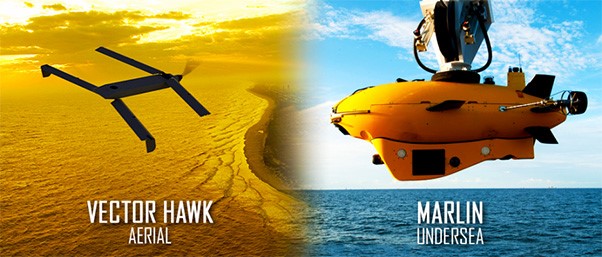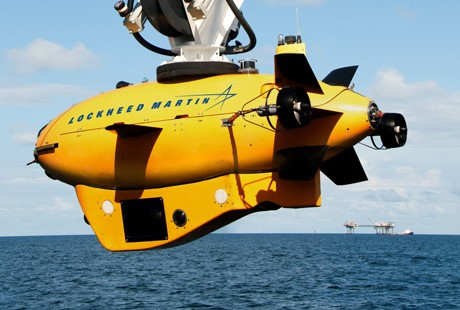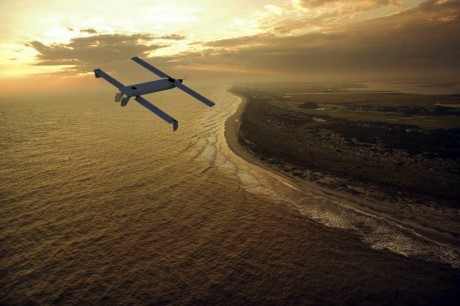
During this year’s Annual Navy Technology Exercise (ANTX) in Rhode Island’s Narragansett Bay, a three-day Naval exercise conducted by Lockheed Martin and Ocean Aero upended the traditional U.S. Navy chain of command, deferring administrative mission control from Naval and Air Force commanders to a series of coordinating autonomous vehicles. During the display, an unmanned surface vehicle coordinated the launch of an unmanned aerial vehicle from an unmanned submersible — the world’s first multi-domain, autonomous unmanned vehicle chain.
The exercise began with instructions from a ground control station to Ocean Aero’s Submaran, a wind- and solar-powered unmanned surface vehicle (USV) that can be outfitted with a variety of sensors for different surveillance applications.

Ocean Aero’s Submaran.
The Submaran, in turn, relayed command instructions to Lockheed Martin’s submerged Marlin MK2 autonomous underwater vehicle (UAV) via underwater acoustic communications. The 10-ft. battery-powered UAV is equipped with sophisticated sensors and robust autonomy and is able to cruise for 24 hours, descend up to 1,000 feet and manage a maximum payload of up to 250 lbs. The Marlin cruised below the surface of the bay to a designated launch site as instructed.

Lockheed Martin’s Marlin MK2.
Once surfaced, the Marlin followed supplementary instructions to ready its payload, a canister containing a Lockheed Martin Vector Hawk, a lightweight, multipurpose autonomous drone (UAV) capable of surveillance and delivering a scalable payload up to 9 miles (line of sight). The Vector Hawk features a field-reconfigurable open architecture to enable rapid technology and payload integration. The UAV can be field-reconfigured to fit multiple mission environments, including fixed-wing, vertical takeoff and landing (VTOL), and tilt-rotor enabling VTOL with transition to fixed wing flight. Once on its predetermined flight path, the autonomous Vector Hawk maintains communication and data linkage using adaptable high-bandwidth software-defined radio, mesh networking (including 3G, 2G, and LTE cellular), and employs over-the-air reconfiguration. The system also incorporates fail-safes to ensure that it can safely return to the user or auto-land when communication or power failures occur.

Lockheed Martin’s Vector Hawk.
Meanwhile, the Marlin and UAV transmitted electro-optical (EO) and infrared (IR) video to the Submaran, which relayed images to the ground station. The Submaran provided additional surface reconnaissance and surveillance for the mission.
Doug Prince of Lockheed Martin business development, unmanned underwater vehicles, commented on the significance of the milestone; “This is the first time that three autonomous vehicles in three different domains [air, surface, and underwater] have worked together to execute a mission.”
The operational status of each vehicle was communicated to and monitored by the ground station, allowing operators full situational awareness and control over each asset.
“This collaborative demonstration brings us another step forward to realizing a future where different unmanned systems work in cooperative operations to support first responders, military operations, and commercial users,” said Prince.
Future civilian and military applications for the coordinating of autonomous vehicles is endless as it helps shift operational focus from commanding and coordinating vehicles to conducting the mission at hand.
Sources: Ars Technica, NewAtlas
Advertisement
Learn more about Electronic Products Magazine





